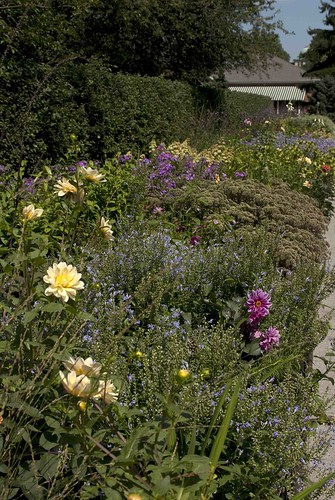Tip of the Week: Think Repetition, Seasonality in Garden Design
Posted in Gardening Tips on September 28 2009, by Sonia Uyterhoeven
 |
Sonia Uyterhoeven is Gardener for Public Education. Join her each weekend for home gardening demonstrations on a variety of topics in the Home Gardening Center. |
 Throughout the long border of the Seasonal Walk different themes are repeated—some based on texture, color, form, and plant choice. In this long border created by renowned Dutch designers Piet Oudolf and Jacqueline van der Kloet, many perennials act as anchors for the design. It is important in any successful design to have repeating dominant themes. They create the architectural structure of the design as well as tie together the composition and give it unity.
Throughout the long border of the Seasonal Walk different themes are repeated—some based on texture, color, form, and plant choice. In this long border created by renowned Dutch designers Piet Oudolf and Jacqueline van der Kloet, many perennials act as anchors for the design. It is important in any successful design to have repeating dominant themes. They create the architectural structure of the design as well as tie together the composition and give it unity.
For the late summer display, Echinacea is one of the major structural components. Oudolf shows off many of his own fabulous cultivars: Echinacea ‘Virgin’ ‘Vintage Wine’, ‘Fatal Attraction’, and ‘Green Jewel’. Repetition gives a border energy and movement.
For every bold anchor plant in the border there is an equally important filler plant whose feathery or airy texture is a necessary contrast to the overall design. In every good design it is important not to over-stimulate the senses. Rest is as important as movement. Calamint (Calamintha nepeta ssp. nepeta), downy skullcap (Scutellaria incana), and mountain mint (Pycnanthemum muticum) are a few underused yet garden-worthy perennials that fit this category. All are wonderful at attracting insects into the garden, and the last two are natives in this region of the country.
One of the greatest lessons to learn from the Oudolf-van der Kloet collaboration is the multi-dimensionality in all seasons. There is not a moment when the garden is quiet, and it evolves in a dynamic way from early spring well into winter.
An exquisite mix of early spring bulbs such as Crocus chrysanthus, Chionodoxa forbesii, Muscari azureum, and Iris reticulata herald the advent of spring. Once these flowers fade, their fine foliage acts as a perfect foil for late-blooming Narcissus and Tulipa. The perennials have started to stir and by the time the late bulbs have faded, the robust foliage of Phlox and other perennials have enough height to hide the straggly foliage of the bulbs.
Senescence doesn’t have to be an awkward time. If well orchestrated, some of the messier scenes can be camouflaged with the emergence of strategically placed plants. At other times, as in the case of the minor bulbs, the fading foliage can contribute to a subsequent “garden moment.”
Seasonal Walk is an outrageous celebration of the plant material. Special attention is paid to the color and texture not only of the flower but of every part of the perennial in combination. Colored stems, burgundy and glaucous foliage, feathery and bold shapes all add to the artistry of the design. Piet Oudolf specializes in garden-worthy perennials—plants that grow well, flower prolifically, and then fade gracefully.
In his highly textural and layered design, plants are paired with each other to bring out their best features. The leggy, egg-shaped flowers of Allium sphaerocephalon pair ingeniously with the elegant spires of Teucrium hircanicum ‘Paradise Delight’. Elegant color harmonies make bold statements by combining contrasting light and dark shades such as the rich burgundy duo of Actaea simplex ‘Brunette’ and Astrantia major ‘Claret’ partnered with the pale, peachy Papaver orientale ‘Karine’.
While the perennials are grouped en masse, many of the bulbs are scattered throughout the borders giving the impression that they are skipping through the perennials. In this manner they make effective accent points. Ornamental onions (Allium) intermingle in perennial drifts. More unusually, dahlias (Dahlia) and less familiar tender bulbs such as hardy gloxinia (Incarvillea delavayi) and summer hyacinth (Galtonia candicans) are interspersed in a similar fashion as accents throughout the border.
These design lessons do not need to be perfected to the level of the Dutch team; they are relevant to gardeners of all levels. Even a beginner can remember to add color accents to borders using spring bulbs and summer annuals.
The effective use of foliage, texture, and color takes more practice. Gleaning ideas from a designer is a perfect way to start. Choose plant combinations that will complement and support each other (sometimes quite literally) through the seasons. Each plant has specific attributes or features; create plant combinations where these features are celebrated rather than hidden.
For chronicle of Seasonal Walk through the year, click here.

